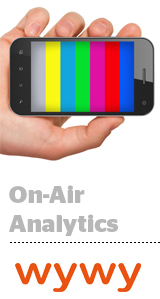 Just about every brand with a TV budget wants the answer to a simple question: How many people took action after seeing my ad on TV?
Just about every brand with a TV budget wants the answer to a simple question: How many people took action after seeing my ad on TV?
But it’s not the type of question that can be answered by a gross rating point (GRP).
To better understand the impact of its TV advertising, Ford and its agency Blue Hive turned to wywy, a Munich-based TV ad-syncing platform, to take advantage of its tool designed to track TV ad creative in real time. Blue Hive and Ford are early adopters of the technology, which exited beta in early September.
The tool was designed to fill in data gaps left by GRPs, which measure the impact of an advertising campaign by multiplying an estimation of the target market reached by the exposure frequency. But GRPs don’t measure sales, test drives or intent – and that’s a major limitation.
“We still report on GRPs and continue to run Nielsen ad effectiveness tests for the creative, [but] TV measurement and analytics has progressed into more detailed attribution and media mix modeling,” said Bill Pellett, digital media director at Blue Hive. The client-specific shop formed in 2010 with talent from WPP agencies Ogilvy, Wunderman and Mindshare to handle all of Ford’s strategy, media planning and CRM business in Europe, à la Team Detroit in North America.
Other wywy clients include Mediacom, Xaxis, Amnet, Cadreon, Nissan, Hyundai, BMW and Suzuki.
Blue Hive needed to look elsewhere to justify its TV spend, Pellett said, noting that “a lot of the current modeling work involves local dealership input, which isn’t always the most scientific.”
To gather data on the impact of its TV ads, advertisers can use the wywy tool to drop a tracking pixel onto their websites. The tool pings in real time whenever a TV spot airs, creating an automatic time stamp of exactly what ran when and where and in the midst of which program. Lift in web activity immediately following the airing is attributed to the TV spot, while also taking into consideration how that lift compares to the baseline.
The tool adjusts for any difficult-to-plan timing changes along the way. With a football game, for example, it’s hard to predict the timing of breaks. Although the media plan might call for a spot to air at exactly 5:45 p.m., overtime could push the ad to 5:48 p.m. – and that messes with the attribution.
For the same reason, wywy’s analytics solution also normalize any minor differences in timekeeping between the networks, smoothing out any discrepancies if, say, Network A’s clock is one minute faster than Network B’s – because every second does count.
“We’ve seen 80% of website traffic happen within 90 seconds of a TV ad airing,” said Andreas Schroeter, COO and co-founder of wywy.
Website traffic is great, but people don’t generally buy their cars online. They do, however, head to the web to do research before hitting a dealership.
“Locating a dealer, configuring a car, downloading a brochure – these are all signals of intent,” Schroeter said. “Although not everyone who searches for a dealership will visit a dealership, it’s a logical step toward conversion.”
Blue Hive uses wywy to identify specific spots in certain programs that “may not have previously been given the credit they deserve,” Pellett said.
“We all know from the research and our own experience that more people are second-screening while they watch TV,” he said. “For some, it’s a distraction and for others it’s becoming an integral part of their TV consumption habits – [but], either way, syncing digital with TV allows us to either capture the TV audience lost through distraction or [to] augment the branding effect or purchase intent through complementary [cross-device] messaging.”
The agency also uses wywy’s tech for prospecting. If there isn’t budget or available creative to run a TV campaign for Ford, Blue Hive can peg digital campaigns to dovetail with a competitor’s TV activity.
Wywy has ramped up its analytics offerings over the last several months. In July, it announced a partnership with mobile attribution company Appsflyer to start measuring the impact of television on app installs.
Next on the agenda, wywy wants to integrate with the bodies that provide GRP data, including Nielsen in the US and BARB – which stands for the Broadcasters’ Audience Research Board – in the UK. Most advertisers come out of the GRP world, Schroeter said, and it makes them more comfortable to have access to that data.
“Clients want to make the connection between traditional audience metrics and what we call engagement metrics,” said Schroeter. “They just want to know how it translates.”













